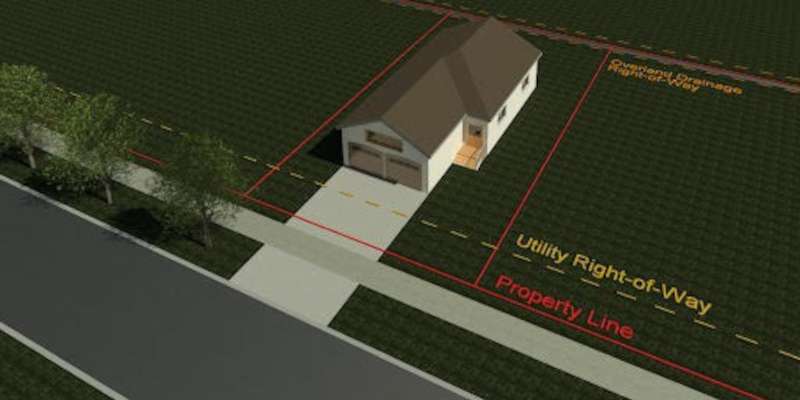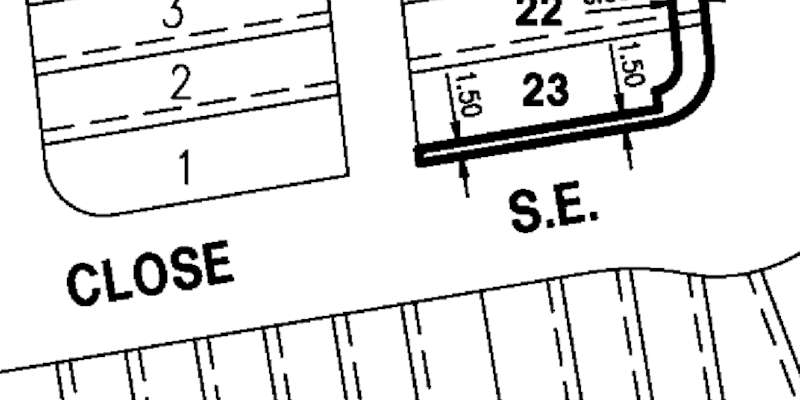Utility Right of Ways

A Utility Right of Way is a portion of land owned by one property owner in which rights of access are granted to another. Many parcels of land in Alberta have a Utility Right of Way (U.R.W.) on them. While there are good reasons for these to exist, more recently, many municipalities take a more aggressive approach to enforcing the rights associated with these portions of property and the rights associated with them. As a result of this rise in recent municipal enforcement, our clients are increasingly asking questions regarding utility right of ways: where they are, why they exist, and their impact on homeowners and real estate transactions.
What are Utility Right of Ways (U.R.W.)?
There is often a public need to install common infrastructure such as cable, telephone, water, sewage, and gas to service many homes in an area.In Alberta, the typical arrangement is to install utilities on private land. The mechanism used to allow this is by means of a right of way agreement registered on the land title. This lays out what rights are created, who has these rights, and the location of these rights. The location can be defined three ways:registered on a plan, written into a description on the title, or through a blanket registration on the entirety of the property.The following are examples and descriptions of each:
Registered on a Plan
The current standard, and most common way, to define the location of the rights is through a plan registered by an Alberta Land Surveyor for this purpose at the Alberta Land Titles office. This plan will clearly, graphically, indicate the size and location of the right of way on the parcel.

Description on Title
The second way the location may be referenced, seen on older right of ways, is by a description on the title such as “the south 25 feet” of the parcel.

Blanket Registration
The third way, used almost exclusively on rural properties with gas cooperatives, is known as a blanket registration. With a blanket registration the entire parcel is subject to the right of way, and the rights allow access to the entire property regardless of the utilities location.

Where are they located?
The most common location and size for the right of way in new communities is the front 3.50 metres (11.5 feet) of the property. In older areas, 3.05 metres (10 feet) is common. Corner lots often have a smaller right of way running down the side of the parcel (property). Other types of right of ways can exist, and will be linked in a new post, when it becomes available.
Why do they exist?
It should be made clear that the land subject to the right of way is still part of the parcel owned by the landowner. Despite this, the right of way grants rights to others for some use of the land. Most utility right of ways limit rights to subsurface rights, but with stipulations on what can be built above. Namely there are rights to install, upgrade and maintain services mentioned above but the agreement may also additionally note that structures will not be allowed to be built on the right of way area.
What is their impact on land owners?
The most common interaction however most people will have with right of ways is when they sell their home and require a Real Property Report (R.P.R.). An important aspect of utility right of ways to appreciate is that, from a land surveying / Real Property Report (RPR) perspective, the concern is where the legal right of way is located, not where the utility infrastructure is in fact located. One current example of how these right of ways impact land owners is the recent push for internet service companies to upgrade their cable and telephone lines to fibre optic for increased service speeds; the right of the service provider to enter and do construction on private property is derived from the utility right of way document registered on the parcel.
It can also be the case that the utilities are installed outside the right of way, and a portion of the service is almost always branched off of the main line to service the building on the parcel. These ‘branches’ are not typically covered under the right of way agreement, as it is solely for the use of that particular land owner, not for the public as a whole accessing the service line. Such branches are not indicated on a Real Property Report or indicated on a registered plan. Therefore, knowing the location of the legal right of way is NOT a replacement for having the actual utilities located for the purpose of excavation (e.g. installing fence posts, landscaping, etc.). If you need to know the locations of utilities for construction, please reach out to:
Click before you dig
or
Utility Safety Partners (Previously known as Alberta One Call).
How does this affect my Real Property Report (RPR) and possible real estate transactions?
It is a requirement of Real Property Reports ( RPR’s) used for real estate transactions to show any and all encroachments associated with a property. Encroachments are any structures which interfere with the access to the right of way. Plant life or non permanent structures (e.g. patio furniture, moveable planters, etc.) may not be shown. While an exhaustive list of structures that could be shown is impossible, the most common, and most problematic, are retaining walls.
The municipalities surrounding Calgary (Chestermere, Cochrane, Airdrie, etc.) have their own enforcement policies for encroachments. The City of Calgary now requires either an encroachment consent letter or an encroachment agreement for essentially all encroachments. The typical total cost (including the Surveyor, City and Land Titles fee, if needed) to have a surveyor process the needed approvals to allow the encroachments to remain range anywhere from $50 - $1500.
The part our clients find most frustrating, however, is the significant timelines for processing such agreements. The encroachments department at the City of Calgary is currently taking about 9 weeks just to let you know what agreement is required to allow the encroachments to remain, and about an additional 4-6 or more months to execute once given the go ahead. This is longer than most buyers/sellers are willing to wait. The typical solution is for the real estate transaction to go through as usual, but with what is called a holdback of some funds from the sale, usually about $5,000-$10,000. Rarely, but sometimes, the “worst case” costs are associated with having to remove the encroachment. This money will be held in trust until the RPR receives the necessary approval.
When encroachments exist, homeowners can expect increased costs, and substantial increased delays after the sale of the property. A homeowner should consider the impact of the encroachments, and evaluate options. It might make more sense to remove the offending encroachment, this is a conversation you should have with both your lawyer and Alberta Land Surveyor. We are here to help you navigate these situations.